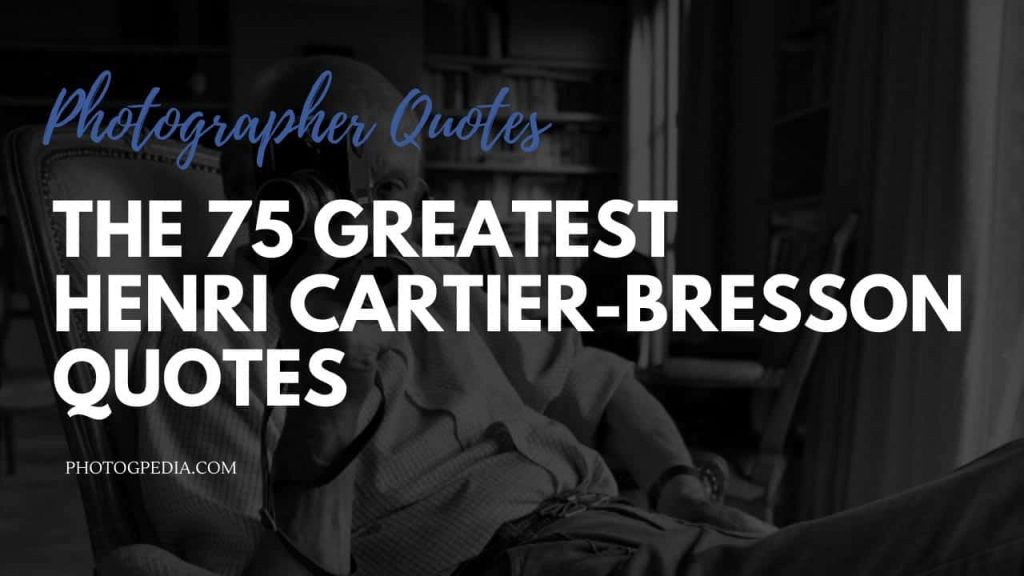In this article, we have listed 75 of the very best Henri Cartier-Bresson quotes, which are sure to inspire, motivate, and help take your photography to the next level.
They say, to be the best, you have to learn from the best. Cartier-Bresson is undoubtedly one of the all-time photography greats.
Before reading the article, we recommend checking out our Henri Cartier-Bresson profile article to learn more about his legendary career and photography philosophy.
If you enjoy the article or find it helpful, then don’t forget to share it with others through the usual channels (social media, forums, websites, etc).
Related Article: The 100 Greatest Photography Quotes
Famous Henri Cartier-Bresson Quotes
To me, photography is the simultaneous recognition, in a fraction of a second, of the significance of an event.
Your first 10,000 photographs are your worst.
Sharpness is a bourgeois concept.
The picture is good or not from the moment it was caught in the camera.
To take a photograph is to align the head, the eye and the heart. It’s a way of life.
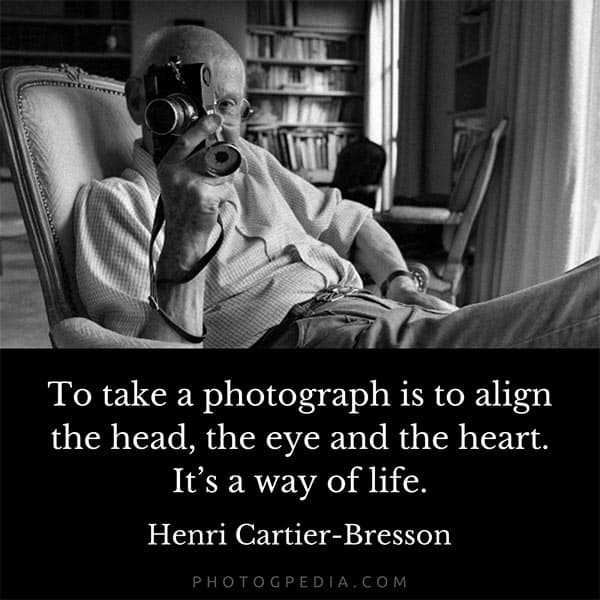
It is an illusion that photos are made with the camera… they are made with the eye, heart and head.
Henri Cartier-Bresson
Photography is a way of living. To me, my camera is an extension of my eye. I keep it all the time with me.
For me the camera is a sketchbook, an instrument of intuition and spontaneity, the master of the instant which, in visual terms, questions and decides simultaneously. It is by economy of means that one arrives at simplicity of expression.
The difference between a good picture and a mediocre picture is a question of millimeters – small, small differences – but it’s essential. I didn’t think there is such a big difference between photographers. But it is that little difference that counts, maybe.
Related Article: Quote Series: What Makes a Good Photograph?
Cartier-Bresson Quotes on the Photography Process
To take a photograph is to hold one’s breath when all faculties converge in a face of fleeing reality. It is at that moment that mastering an image becomes a great physical and intellectual joy.
Of all the means of expression, photography is the only one that fixes forever the precise and transitory instant. We photographers deal in things that are continually vanishing, and when they have vanished, there is no contrivance on earth that can make them come back again.
My passion has never been for photography “in itself,” but for the possibility – through forgetting yourself – of recording in a fraction of a second the emotion of the subject, and the beauty of the form; that is, a geometry awakened by what’s offered. The photographic shot is one of my sketch pads.
The photograph itself doesn‘t interest me. I want only to capture a minute part of reality.
Photography is an immediate reaction, drawing is a meditation.
For me, photography is instant drawing. For me, the passion is to look, to look, to look.
That’s why photography is important, in a way, because at the same time that it’s a great pleasure getting the geometry together, it goes quite far in a testimony of our world, even without knowing what you are doing.
Only the results count, and the conclusive evidence is the finished photographic print; otherwise there would be no end to the number of tales photographers would tell about pictures which they ever-so-nearly got– but which are merely a memory in the eye of nostalgia.
I‘m not all that interested in the subject of photography. Once the picture is in the box, I‘m not all that interested in what happens next. Hunters, after all, aren‘t cooks.
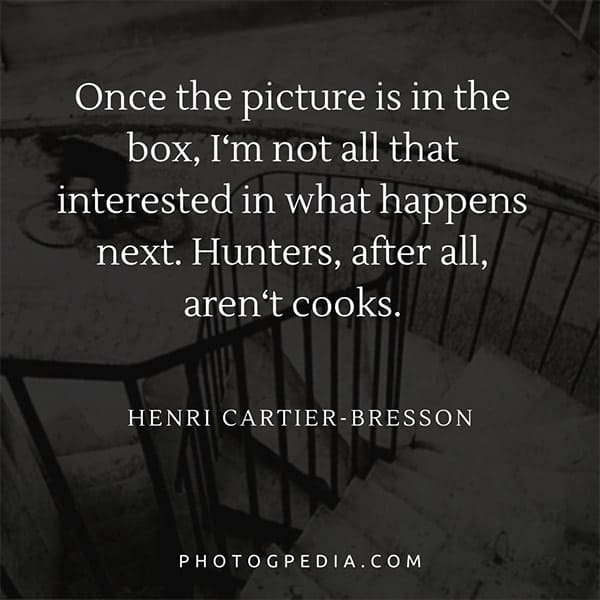
Finding your Subject
Subject does not consist of a collection of facts, for facts in themselves offer little interest. Through facts, however, we can reach an understanding of the laws that govern them, and be better able to select the essential ones which communicate reality.
I believe that, through the act of living, the discovery of one-self is made concurrently with the discovery of the world around us, which can mold us, but which can also be affected by us. A balance must be established between these two worlds – the one inside us and the one outside us. As the result of a constant reciprocal process, both these worlds come to form a single one. And it is this world that we must communicate.
Well, sometimes the pictures disappear and there’s nothing you can do. You can’t tell the person, “Oh, please smile again. Do that gesture again.” Life is once, forever.
In photography, you’ve just got the intuition. And it’s there. You’ve done it. The only way to correct is to make the next picture.
[My] best pictures were in that book, ‘The Decisive Moment. I took them when I was 20. Immediately, after a fortnight. The first day I started pictures. It’s in that book. That’s why teaching and learning is nothing. It’s living and looking. All these photography schools are a gimmick. What are they teaching? Could you teach me how to walk?
Henri Cartier-Bresson
It’s a question of concentration. Concentrate, think, watch, look and, ah, like this, you are ready. But you never know the culminative point of something. So you’re shooting. You say, “Yes. Yes. Maybe. Yes.” But you shouldn’t overshoot. It’s like overeating, over-drinking. You have to eat, you have to drink. But over is too much. Because by the time you press, you arm the shutter once more, and maybe the picture was in between.
Very often I see photographers cultivating the strangeness or awkwardness of a scene, thinking it is poetry. No. Poetry is two elements which are suddenly conflict – a spark between two elements. But it’s given very seldom, and you can’t look for it. It’s like if you look for inspiration. No, it just comes by enriching yourself and living.
Henri Cartier-Bresson
You have to forget yourself. You have to be yourself and you have to forget yourself so that the image comes much stronger — what you want by getting involved completely in what you are doing and not thinking. Ideas are very dangerous. You must think all the time, but when you photograph, you aren’t trying to push a point or prove something. You don’t prove anything. It comes by itself.
Photography Technique Quotes
[The Leica] became the extension of my eye. I prowled the streets all day, feeling very strung up and ready to pounce, determined to “trap life” – to preserve life in the act of living. Above all, I craved to seize the whole essence, in the confines of one single photograph.
Henri Cartier-Bresson
A photographer is part pick-pocket and part tightrope dancer.
If I go to a place, it’s not to record what is going on only. It’s to try and have a picture which concretizes a situation in one glance and which has the strong relations of shapes. And when I go to a country, well, I’m hoping always to get that one picture about which people will say, “Ah, this is true. You felt it right.
Memory is very important, the memory of each photo taken, flowing at the same speed as the event. During the work, you have to be sure that you haven‘t left any holes, that you‘ve captured everything, because afterwards it will be too late.
Henri Cartier-Bresson
And I must say the important picture is the next one you’re going to take. We’re not curators of our work. The important is to think about the next subject.
Technique is important only insofar as you must master it in order to communicate what you see. Your own personal technique has to be created and adapted solely in order to make your vision effective on film.
Related Article: Quote Series: Street Photography Quotes
Capturing the Image
In photography, the smallest thing can be a great subject. The little human detail can become a leitmotiv.
Henri Cartier-Bresson
You mustn’t want. You must be receptive.
A photograph is neither taken or seized by force. It offers itself up. It is the photo that takes you. One must not take photos.
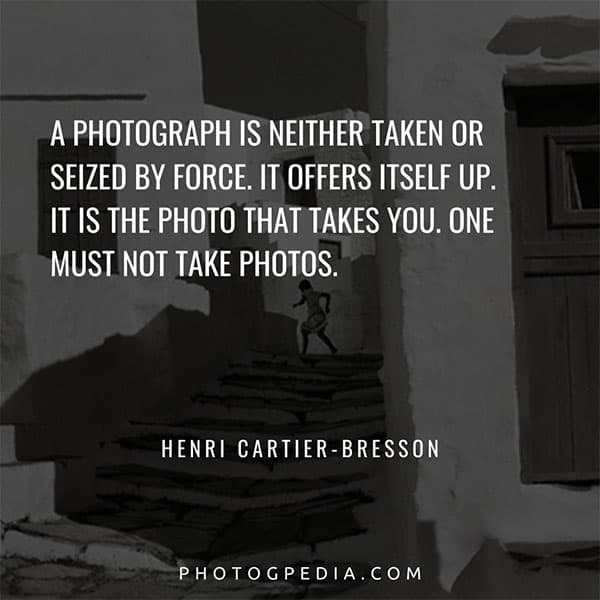
When something happens, you have to be extremely swift. Like an animal and a prey – vroom! You grasp it and people don’t notice that you have taken it. Very often in a different situation, you can take one picture. You cannot take two. Take a picture and look like a fool, look like a tourist. But if you take two, three pictures, you got trouble. It’s good training to know how far you can go. When the fruit is ripe, you have to pluck it. Quick! With no indulgence over yourself, but daring. I enjoy very much seeing a good photographer working. There’s an elegance, just like in a bullfight.
Henri Cartier-Bresson
Sometimes it happens that you stall, delay, wait for something to happen. Sometimes you have the feeling that here are all the makings of a picture – except for just one thing that seems to be missing. But what one thing? Perhaps someone suddenly walks into your range of view. You follow his progress through the viewfinder. You wait and wait, and then finally you press the button – and you depart with the feeling (though you don’t know why) that you’ve really got something.
My contact sheets may be compared to the way you drive a nail in a plank. First, you give several light taps to build up a rhythm and align the nail with the wood. Then, much more quickly, and with as few strokes as possible, you hit the nail forcefully on the head and drive it in.
The Decisive Moment Quotes
The creative part of photography is very short. A painter can elaborate, a writer can, but as it’s given, we have to pick that moment, the decisive moment, it is there.
Henri Cartier-Bresson
The creative act lasts but a brief moment, a lightning instant of give—and-take, just long enough for you to level the camera and to trap the fleeting prey in your little box.
It’s instinct. We don’t know why, we press at a certain moment. It comes, it is there, it’s given. Take it. Everything is there, it is a question of chance, but you have to pick and force chance to come to you. There’s a certain will.
Think about the photo before and after, never during. The secret is to take your time. You must not go too fast. The subject must forget about you. Then, however, you must be quick.
Composition must be one of our constant preoccupations, but at the moment of shooting it can stem only from our intuition, for we are out to capture the fugitive moment, and all the interrelationships involved are on the move.
Henri Cartier-Bresson
To take photographs means to recognize – simultaneously and within a fraction of a second – both the fact itself and the rigorous organization of visually perceived forms that give it meaning. It is putting one‘s head, one‘s eye and one‘s heart on the same axis.
When a photographer raises his camera at something that is taking place in front of him, there is one moment at which the elements in motion are in balance. Photography must seize upon this moment.

Relationship with Subject
The profession depends so much upon the relations the photographer establishes with the people he’s photographing, that is a false relationship, a wrong word or attitude, can ruin everything. When the subject is in any way uneasy, the personality goes away where the camera can’t reach it.
In whatever one does, there must be a relationship between the eye and the heart. One must come to one’s subject in a pure spirit. One must be strict with oneself. There must be time for contemplation, for reflection about the world and the people about one. If one photographs people, it is their inner look that must be revealed.
Cartier-Bresson Composition Quotes
Your eye must see a composition or an expression that life itself offers you, and you must know with intuition when to click the camera.
Henri Cartier-Bresson
We look at and perceive a photograph, as we do a painting, in its entirety and all in one glance. In a photograph, composition is the result of a simultaneous coalition, the organic coordination of elements seen by the eye. One does not add composition as though it were an afterthought superimposed on the basic subject material, since it is impossible to separate content from form. Composition must have its own inevitability about it.
Freedom for me is a strict frame, and inside that frame are all the variations possible. Maybe I’m classical. The French are like that. I can’t help it!
If a photograph is to communicate its subject in all its intensity, the relationship of form must be rigorously established. Photography implies the recognition of a rhythm in the world of real things. What the eye does is to find and focus on the particular subject within the mass of reality; what the camera does is simply to register upon film the decision made by the eye.
Henri Cartier-Bresson
For me, content cannot be separated from form. By form, I mean a rigorous geometrical organization of interplay of surfaces, lines and values.
The greatest joy for me is geometry; that means a structure. You can’t go shooting for structure, for shapes, for patterns and all this, but it is a sensuous pleasure, an intellectual pleasure, at the same time to have everything in the right place. It’s a recognition of an order which is in front of you.
Black and White and Color Photography Quotes
In talking about composition we have been so far thinking only in terms of that symbolic color called black. Black-and-white photography is a deformation, that is to say, an abstraction. In it, all the values are transposed; and this leaves the possibility of choice.
Photographers using color have had a tendency to confine themselves to static subjects; or else to use ferociously strong artificial lights. The slow speed of color film reduces the depth of focus in the field of vision in relatively close shots; and this cramping often makes for dull composition. On top of that, blurred backgrounds in color photographs are distinctly displeasing.
[On color photography] It’s disgusting. I hate it! I’ve done it only when I’ve been to countries where it was difficult to go and they said, “If you don’t do color, we can’t use your things.” So it was a compromise, but I did it badly because I don’t believe in it.
You can’t accept everything of nature. You have to select things. It’d rather do paintings, and it becomes an insoluble problem. Especially when it comes to reportage, color has no interest whatsoever except that people do it because it’s money. It’s always a money problem.
Henri Cartier-Bresson
Camera Equipment Quotes
I am completely and have always been uninterested in the photographic process. I like the smallest camera possible, not those huge reflex cameras with all sorts of gadgets. When I am working, I have an M3 because it’s quicker when I’m concentrating.
If you have little equipment, people don’t notice you. You don’t come like a show-off. It seems like an embarrassment, someone who comes with big equipment.
Henri Cartier-Bresson
And photo electric cells in a camera – I don’t see why it is done. It is a laziness. During the day, I don’t need a light meter. It is only when light changes very quickly at dusk or when I’m in another country, in the desert or in the snow. But I guess first, and then I check. It is good training.
Photography has not changed since its origin except in its technical aspects, which for me are not important.
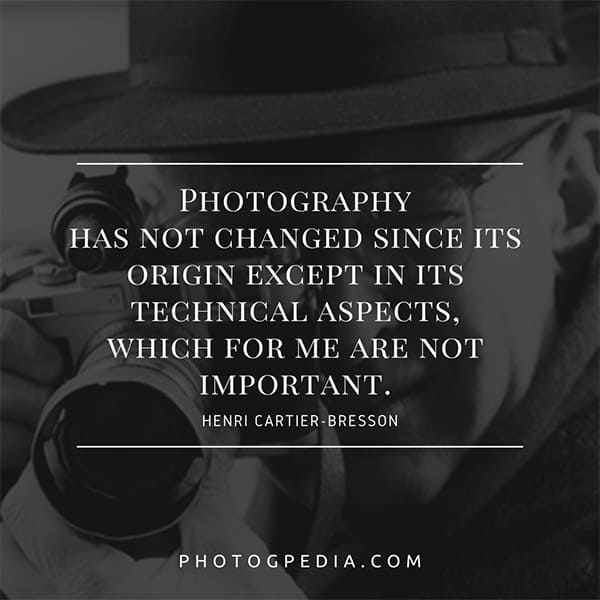
Above all, the sitter must be made to forget about the camera and the photographer who is handling it. Complicated equipment and light reflectors and various other items of hardware are enough, to my mind, to prevent the birdie from coming out.
Henri Cartier-Bresson
We don’t need very big equipment. Practically I work all the time with a 50 mm, a very wide open lens because I never know if I’m going to be in a dark room taking a picture in this moment and outside in full bright sun the next moment.
[On the 50mm lens] It corresponds to a certain vision and at the same time has enough depth of focus, a thing you don’t have in longer lenses. I worked with a 90. It cuts much of the foreground if you take a landscape, but if people are running at you, there is no depth of focus.
The 35 is splendid when needed, but extremely difficult to use if you want precision in composition. There are too many elements, and something is always in the wrong place. It is a beautiful lens at times when needed by what you see. But very often it is used by people who want to shout. Because you have a distortion, you have somebody in the foreground and it gives an effect. But I don’t like effects. There is something aggressive, and I don’t like that. Because when you shout, it is usually because you are short of arguments.
Henri Cartier-Bresson
Related Article: Quote Series: Photography Equipment Quotes
Photography Career
I kept on working. Now it is a very big problem because there are hardly any magazines. No big magazine is going to send you to a country because everybody has been there. It’s another world. But there are heaps of specialized magazines who are going to use your files. And you can make quite a decent living just by files. But it means you have to add pictures for years and years. For a young photographer to start is quite a problem nowadays.
When I started photography in 1930 there were hardly any picture magazines, there was no market. And I was taking pictures (..) things that struck me, interested me. I was keeping a kind of diary. And I still do keep a photography diary. And later, there were magazines, and working for magazines, you have to work for yourself, always for yourself, you express yourself. With magazines, they put you into contact with events important in the world, and you have a possibility of speaking to a very large audience.
Why do photographers start giving numbers to their prints? It’s absurd. What do you do when the 20th print has been done? Do you swallow the negative? Do you shoot yourself? It’s the gimmick of money.
I think a print should be signed. That means a photographer recognizes that the print has been done either by him or according to his own standards. But a print is not like an etching, where the plate wears out. A negative doesn’t wear out.
Henri Cartier-Bresson
Photography allowed me to lead the life I had chosen. I was very curious about the world.
Cartier-Bresson on Photojournalism
What is photojournalism? Occasionally, a very unique photo, in which form is precise and rich enough and content has enough resonance, is sufficient in itself – but that‘s rarely the case. The elements of a subject that speak to us are often scattered and can‘t be captured in one photo; we don‘t have the right to force them together, and to stage them would be cheating… which brings us to the need for photojournalism.
Journalism has kept me from going stale, and through photo assignments I am able to see many new places, but I am not a journalist. I simply sniff around and take the temperature of a place.
Henri Cartier-Bresson
Related Article: Photojournalism and Documentary Photography Quotes
I’m not interested in documenting. Documenting is extremely dull and I’m a very bad reporter. When I had an exhibit at the Museum of Modern Art in 1946, my friend, Robert Capa, told me, “Henri, be very careful. You must not have a label of a surrealist photographer. If you do, you won’t have an assignment and you’ll be like a hothouse plant. Do whatever you like, but the label should be ‘photojournalist.
Cartier-Bresson On Portraits
The most difficult thing for me is not street photography. It’s a portrait. The difference between a portrait and a snapshot is that in a portrait, a person agreed to be photographed. But certainly it’s like a biologist and his microscope. When you study the thing, it doesn’t react as when it’s not studied. And you have to try and put your camera between the skin of a person and his shirt, which is not an easy thing, because you steal something. The strange thing is that you see people naked through your viewfinder. And it’s sometimes very embarrassing.
I’m always nervous when I go to take a portrait, because it’s a new experience. Usually when taking a portrait, I feel like putting a few questions just to get the reaction of a person. It’s difficult to talk at the same time that you observe with intensity the face of somebody. But still, you must establish a contact of some sort.
Whereas with Ezra Pound, I stood in front of him for maybe an hour and a half in utter silence. We were looking at each other in the eye. He was rubbing his fingers. I took maybe altogether one good photograph, four other possible, and two which were not interesting. That makes about six pictures in an hour and a half. And no embarrassment on either side.
Henri Cartier-Bresson
Have a Favorite Henri Cartier-Bresson Quote?
Have a favorite HCB quote? Know any other Henri Cartier-Bresson quotes that would make a great addition to the list? Let us know in the comment section below.
Don’t forget to bookmark this page, or print it out, and refer to it next time you need some inspiration. Also, don’t forget to share it with others.
Looking for more words of wisdom from master photographers? Check out the quotes section of Photogpedia for more great photography quotes.

